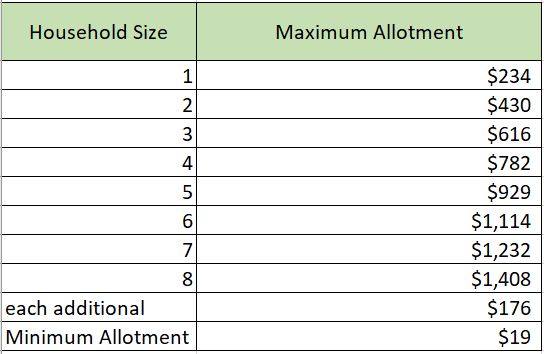At the beginning of the COVID-19 pandemic in March 2020, the Families First Coronavirus Response Act (FFCRA) allowed the Food and Nutrition Service (FNS) through the U.S. Department of Agriculture (USDA) to expand the Supplemental Nutrition Assistance Program (SNAP), formerly known as food stamps, through Emergency Allotments (EA). EAs ensure each SNAP household receives the maximum benefit amount for their household size.
To receive SNAP EAs, a state must apply for an extension every month and meet certain requirements. Every state has chosen to use EAs to expand SNAP benefits to recipients in their state throughout the pandemic, including Ohio.
Under the FFCRA, recipients not already receiving the maximum SNAP benefit for their household size would receive an EA supplement. This meant that households already receiving the maximum benefit amount, and therefore the most in need, received no additional SNAP support. To correct this, the Consolidated Appropriations Act of 2021 increased all SNAP benefits by 15%, an average of $28 per Ohioan per month.
SNAP Maximum Allotments, used to determine how much EA an enrollee should receive.
Source: https://emanuals.jfs.ohio.gov/CashFoodAssist/FACM/FACT/FACT-80.stm
Later, in April 2021, FNS released new guidance bringing all SNAP Emergency Allotments up to at least $95 per month, regardless of if the individual was already receiving the maximum benefit. As a result, in May 2021, 741,494 Ohio households received Emergency Allotments, totaling $122.5 million in 100% federally funded benefits flowing into the state.
SNAP EAs have brought $1.2 billion in federal funds into the state since March 2020. In order for Ohio to continue to receive SNAP EAs from FNS, both the federal public health emergency and the state emergency declaration must be in place.
If the state’s emergency declaration were to end, the Ohio National Guard’s deployment to 14 Ohio food bank locations to assist with the staggering need for food assistance across the state would also end.
To accommodate the ending of many states’ emergency declarations, FNS has announced that a state can apply to receive a SNAP EA extension for one month after the month in which that state’s emergency declaration ends, but one month is not enough to prevent the enormous cliff SNAP recipients will face once EAs end.
None of the COVID-19 assistance programs will last forever, but policy makers need to craft a plan to address food insecurity in Ohio. The pandemic is not over, and the pandemic’s effects on Ohioans will linger for years to come. It’s vital that the COVID-19 disaster declaration remains in-tact until Ohio’s economy has recovered so families continuing to struggle from the pandemic can continue to receive necessary support to stabilize and get back on their feet.
by: Sarah Hudacek, AOF Policy Assistant


